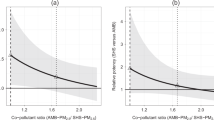Abstract
A large study was conducted to assess exposure to environmental tobacco smoke (ETS) in a geographically dispersed study population using personal breathing zone air sampling and salivary cotinine levels. Approximately 100 self-reported nonsmoking subjects in each of 16 metropolitan areas were recruited for this investigation. Cumulative distributions of salivary cotinine levels for subjects in smoking and nonsmoking homes and workplaces exhibited a general trend of decreasing salivary cotinine levels with decreasing time spent in smoking environments. Median salivary cotinine levels for the four experimental cells in the study (product of smoking and nonsmoking home and workplaces) were comparable to those reported for a large national study of serum levels of cotinine (Third National Health and Nutrition Examination Survey, NHANES III), when the latter was corrected for expected differences between serum and saliva concentrations. However, the most highly exposed group in this study had a median salivary cotinine concentration approximately a factor of 2 greater than that of the comparable group in the NHANES III study. Misclassification rates, both simple (for self-reported nonsmokers) and complex (self-reported lifetime never smokers), were near the median of those reported for other studies. Estimated misclassification rates for self-reported lifetime never-smoking females are sufficiently high (2.95% using a discrimination level of 106 ng/ml) that, if used in the Environmental Protection Agency (EPA) risk assessment related to ETS and lung cancer, would place the lower 90% confidence interval (CI) for relative risk at nearly 1.00, i.e., no statistically significant increased risk. For the 263 most highly exposed subjects in the study whose self-reported nonsmoking status was accurate, the correlation between airborne exposure to nicotine and average salivary cotinine is so small, on an individual basis, that it makes the relationship useless for estimating exposure on a quantitative basis. When subjects are grouped according to likely categories of nicotine exposure, correlation between group median airborne nicotine exposure and salivary cotinine level increases dramatically. The comparison improves for the most highly exposed subjects, suggesting that such quantitative comparisons are useful for only those subjects who are exposed to the higher levels of ETS. However, airborne nicotine exposure for most of the subjects does not account for estimated systemic levels of nicotine, based on salivary cotinine levels.
This is a preview of subscription content, access via your institution
Access options
Subscribe to this journal
Receive 6 print issues and online access
$259.00 per year
only $43.17 per issue
Buy this article
- Purchase on Springer Link
- Instant access to full article PDF
Prices may be subject to local taxes which are calculated during checkout
Similar content being viewed by others
Author information
Authors and Affiliations
Corresponding author
Rights and permissions
About this article
Cite this article
JENKINS, R., COUNTS, R. Personal exposure to environmental tobacco smoke: salivary cotinine, airborne nicotine, and nonsmoker misclassification. J Expo Sci Environ Epidemiol 9, 352–363 (1999). https://doi.org/10.1038/sj.jea.7500036
Accepted:
Published:
Issue Date:
DOI: https://doi.org/10.1038/sj.jea.7500036
Keywords
This article is cited by
-
Atomoxetine treatment for nicotine withdrawal: a pilot double-blind, placebo-controlled, fixed-dose study in adult smokers
Annals of General Psychiatry (2012)
-
Current cigarette smoking among in-school American youth: results from the 2004 National Youth Tobacco Survey
International Journal for Equity in Health (2009)
-
Prevalence, correlates of and perceptions toward cigarette smoking among adolescents in South Korea
The Indian Journal of Pediatrics (2009)
-
Antismoking messages and current cigarette smoking status in Somaliland: results from the Global Youth Tobacco Survey 2004
Conflict and Health (2008)
-
Prevalence and determinants of adolescent tobacco smoking in Addis Ababa, Ethiopia
BMC Public Health (2007)



